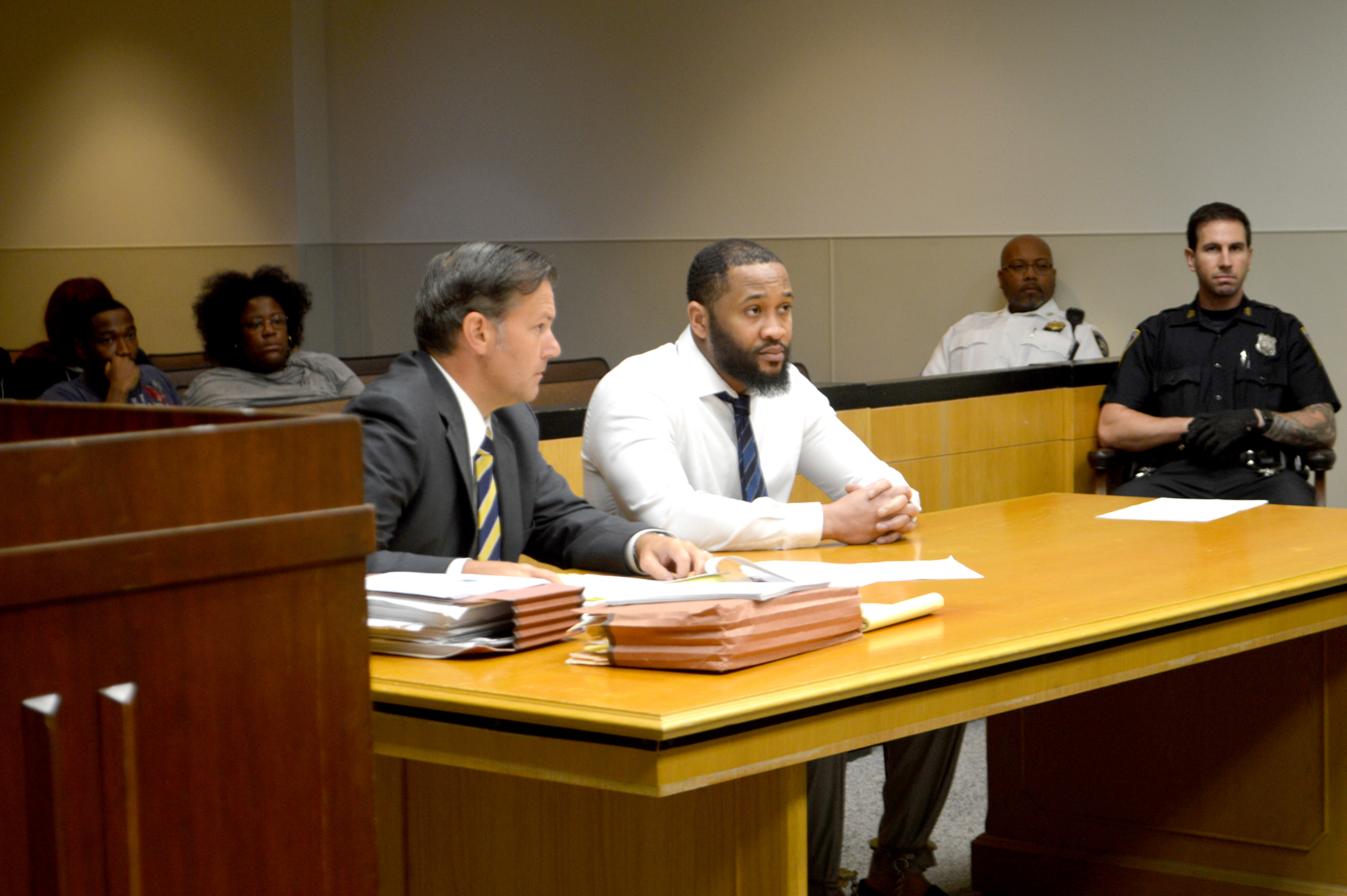Not Guilty In Fentanyl OD Manslaughter Trial

On September 12, an alleged Greenport narcotics dealer was found not guilty of the manslaughter of a Riverhead man, Lawrence Yaccarino, who died of a drug overdose involving fentanyl in August 2018. LaShawn Lawrence, 35, was found guilty of a lesser crime, criminal conspiracy, after a seven-day bench trial in the Riverside courtroom of New York State Supreme Court Justice Anthony Senft.
Besides Lawrence, there are two co-defendants in the case, John Brophy of Greenport and Bryan Hale of Flanders. Both men took guilty pleas in August, with Brophy pleading to the same manslaughter charge of which Lawrence was acquitted. That manslaughter charge carries a sentence of up to 15 years in state prison. In addition, Brophy had been facing eight felony heroin distribution-related charges. He pleaded guilty to one of those felonies, a charge of criminal conspiracy to sell heroin.
The Greenport man was the one who sold heroin mixed with fentanyl to Yaccarino. Brophy, in turn, was supplied with heroin by Lawrence, according to the police. Lawrence was convicted of conspiring with Brophy to distribute narcotics.
Brophy has been held in county jail since his March 11 arraignment, unable to post the $125,000 bail amount set by Senft. He sold the narcotics out of Hale’s Riverhead auto repair shop.
Hale was charged with five felonies related to selling heroin. He pleaded guilty to one of those felonies, the attempted sale of heroin. He was released on a $200,000 bond. Both men will be sentenced next month.
The manslaughter charges brought by District Attorney Tim Sini’s office were the first of his administration against alleged heroin dealers whose customers die from overdoses due to the narcotic being laced with fentanyl.
Two other men were charged with manslaughter after fentanyl-related fatal overdoses by Sini’s predecessor, Thomas Spota, in 2016. Sini’s team obtained guilty pleas from both James Fava and Roxy Headley after they took over the DA’s office in 2018. Both men are currently serving time in prison in upstate New York.
This was the first time a manslaughter case stemming from a fentanyl/heroin related overdose death had gone to trial in Suffolk County.
Super-Charged Heroin
Fentanyl, an artificial manmade opioid, is considered a miracle drug for the terminally ill who are in chronic, excruciating pain. The U.S. Centers for Disease Control and Prevention has determined that fentanyl is 50 times more powerful than heroin, and 100 times more powerful than morphine, which used to be the main drug used to treat chronic pain in terminal patients. Both heroin and morphine are derivatives of opium, a flowering plant.
During Lawrence’s trial, Southold Detective Roman Willinski testified about the connection between Brophy and Lawrence, and on the use of fentanyl by drug dealers in general. He said that fentanyl super-charges the heroin, “and gives the user a better high.” Will Nash, the head of the county’s narcotics prosecution bureau, was also at the prosecutor’s table.
The problem with fentanyl, as expressed during the trial, is that it is so powerful that just a small amount can push a drug user over the line and into a potentially deadly overdose. Tanya Rickoff, the prosecuting attorney on the case, said during her closing argument about the dealers pushing fentanyl-laced heroin, “I don’t think they care about who lives and dies.”
Narcan, the drug used by first responders to bring overdose victims back to life, is now being used by drug dealers, as well. Willinski said that Brophy, just days before Yaccarino’s death, had revived a buyer with Narcan after he had taken the fentanyl-spiked heroin sold by Brophy.
The conspiracy to sell heroin between Lawrence and Brophy was via text messages. Willinski walked the court through a long series of messages between the two men. There are references to “fifties,” meaning $50 bags, and “fent,” meaning fentanyl. At one point, Brophy writes, warning “People are dropping. I think it is fent.” Lawrence responds, seemingly denying responsibility, saying “My people ain’t playing like that.”
Sini held a press conference in March following the arraignment of Lawrence, Brophy, and Hale. At the time, he said, “Lawrence Yaccarino is no longer with us. The defendants killed him. Period.” However, the evidence against Lawrence on the manslaughter charge lacked Sini’s certitude.
A key moment in the trial came during the cross examination of Michael Caplan, Suffolk County’s chief medical examiner, by Carl Irace, Lawrence’s attorney.
Peddling Poison
Caplan told the court that there was cocaine and fentanyl in Yaccarino’s system after his death. The resulting concoction of the stimulant cocaine with an opioid is called a speedball and produces a euphoric state in the user. The synergy of the two narcotics is also extremely dangerous. “Synergism is more dangerous than using one drug,” Caplan said.
It was the presence of cocaine in Yaccarino’s body that Irace focused on. There had been no mention of cocaine coming from Lawrence, and no evidence was produced during the trial to that effect. “If there were no other drugs, could the amount of cocaine have caused his death?” Irace asked. “Yes,” Caplan responded.
Irace also pointed out that Yaccarino had overdosed twice in the five days leading up to his death, with both incidents leading to hospitalization. “This is a circumstantial case, built around text messages,” Irace said during his closing. He said that the people had failed to prove a direct link between Lawrence’s conduct and Yaccarino’s death.
“LaShawn Lawrence and his co-conspirators knew they were selling poison,” Rickoff said. “The defendant knew that his product could cause death.”
She closed by saying, “If you peddle poison on the streets of Suffolk County, you will be charged, and you will be tried.”
After hearing the closing arguments, Justice Senft then called the parties back to his courtroom about 90 minutes later, when he pronounced his verdicts. Afterward, Irace asked that bail be reduced from $200,000 to $50,000, which Senft was unwilling to do.
Lawrence will be sentenced October 15. Normally, the crime he was convicted of brings a two to four-year sentence, at most. However, Lawrence, 35, already has four prior felony convictions on his record, one of which is classified as a violent felony, and has previously been found to be in violation of the terms of his parole. Senft could deem Lawrence a “persistent” felon, which would roughly double the time Lawrence potentially faces, and could also mean that, after he is eventually released, Lawrence could face a lifetime of monitoring by the state.
Lawrence’s family, including his mother, attended each court session. His brother, Antoine Lawrence, said afterward, “I would like to send my condolences to family of Mr. Yaccarino.” He said he respects the justice system, “but I don’t think justice was done.”
Joanne Needham, a longtime friend of Yaccarino’s, also attended every day of the trial. “I was with him for 12 years,” she said, adding the two separated geographically because “we couldn’t get sober together.”
A recovering addict, she spoke about the epidemic of overdose deaths due to fentanyl. “Fentanyl is cheaper than heroin. So, they’re putting fentanyl in it to boost the effect. But, if you don’t know, if you are not a chemist and you don’t know exactly what you’re putting in there, you’re basically playing with people’s lives.”
She reflected on her own bout with addiction, and on her late friend’s. “The hardest thing when you are trapped in that cycle of addiction is that feeling like you want to die. But you don’t really want to die. You just don’t see a way out,” she said.
t.e@indyeastend.com



